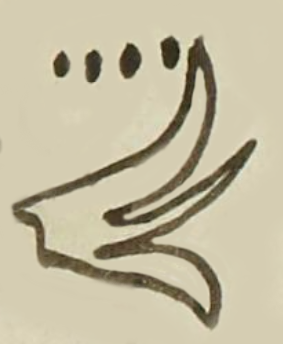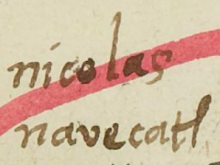Nauhecatl (MH736r)
This black-line drawing of the simplex glyph for the personal name Nauhecatl (“Four Wind” or “4-Wind”) is attested here as a man’s name. It is a calendrical name, which combines the day name ehecatl (here spelled ecatl) meaning the divine force of the wind. Here, this deity is represented by a buccal mask attached to the tribute payer’s mouth. It is shown in profile, facing toward the viewer’s right. Nahuas believed that the deity blew wind through the mask. Above the mask are four (nahui) dots, which provide the numerical companion to the day name. These names were drawn from the religious divinatory calendar (tonalpohualli) of 260 days.
Stephanie Wood
Where we have an accessible gloss, we are retaining the spelling of ecatl, which is what most tlacuilos preferred. However, when it is a calendrical name such as this one, we know it is intending ehecatl.
John Montgomery drew a group of wind glyphs (possibly mainly Mixtec), showing the variety of ways the blowing device might look. It is published in FAMSI, Inc.
Stephanie Wood
1560
Jeff Haskett-Wood
fuerza divina del viento, números, nombres de días, cuatro, mascarillas, tonalpohualli, calendarios, fechas, nombres de hombres

nahui, four, https://nahuatl.wired-humanities.org/content/nahui
eca(tl), air or breath, https://nahuatl.wired-humanities.org/content/ecatl
eheca(tl), wind or the divine force of the wind, https://nahuatl.wired-humanities.org/content/ehecatl
Cuatro Viento, o 4-Viento
Stephanie Wood
Matrícula de Huexotzinco, folio 736r, World Digital Library, https://www.loc.gov/resource/gdcwdl.wdl_15282/?sp=550&st=image
This manuscript is hosted by the Library of Congress and the World Digital Library; used here with the Creative Commons, “Attribution-NonCommercial-ShareAlike 3.0 License” (CC-BY-NC-SAq 3.0).





